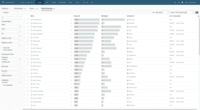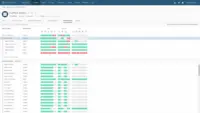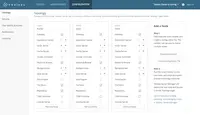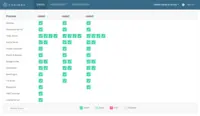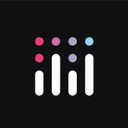Overview
What is Tableau Server?
Tableau Server allows Tableau Desktop users to publish dashboards to a central server to be shared across their organizations. The product is designed to facilitate collaboration across the organization. It can be deployed on a server in the data center,…
An experienced general review for Tableau Server
The WORST company to do business with
Data Analytics with Tableau
Laddy's Tableau Server Review
Pretty. Unstable product + poor support = operations nightmare.
Tableau Server is a world class product
Tableau - Great Visualization at ease
Tableau to the rescue
Tableau - Good Viz, Poor Admin
Failed to meet expectations
Great product but not Cheap
Reviewing Tableau Server
Tableau server is used across multiple departments, with the bulk users in our reporting and finance department.
It allows end users to see …
Tableau Server Review
Tableau Server for Sharing and collaboration of Dasboards
Tableau Server is a great tool for small, medium, and large companies
Awards
Products that are considered exceptional by their customers based on a variety of criteria win TrustRadius awards. Learn more about the types of TrustRadius awards to make the best purchase decision. More about TrustRadius Awards
Popular Features
- Customizable dashboards (94)9.494%
- Drill-down analysis (95)8.787%
- Formatting capabilities (93)8.585%
- Multi-User Support (named login) (93)7.474%
Pricing
Viewer
$12.00
Explorer
$35.00
Creator
$70.00
Entry-level set up fee?
- No setup fee
Offerings
- Free Trial
- Free/Freemium Version
- Premium Consulting/Integration Services
Product Demos
Tableau Server | How to Restore a Backup
Tableau Server | How to Backup Server
How Tableau Works | Tableau Tutorial for Beginners | Tableau Server Online Training | Intellipaat
Installing Tableau Server 10.5 on Linux
Features
BI Standard Reporting
Standard reporting means pre-built or canned reports available to users without having to create them.
- 9.1Pixel Perfect reports(29) Ratings
Pixel Perfect reports are highly-formatted reports with graphics and ability to preview the report before printing.
- 9.4Customizable dashboards(94) Ratings
Customizable dashboards are dashboards providing the builder some degree of control over the look and feel and display options.
- 9.3Report Formatting Templates(81) Ratings
Ad-hoc Reporting
Ad-Hoc Reports are reports built by the user to meet highly specific requirements.
- 8.7Drill-down analysis(95) Ratings
Drill down analysis is the ability to get to a further level of detail by going deeper into the hierarchy.
- 8.5Formatting capabilities(93) Ratings
Ability to format output e.g. conditional formatting, lines, headers, footers.
- 8.9Integration with R or other statistical packages(59) Ratings
Integration with the open-source R predictive modeling environment.
- 9.5Report sharing and collaboration(89) Ratings
Report sharing and collaboration is the ability to easily share reports with others.
Report Output and Scheduling
Ability to schedule and manager report output.
- 9.6Publish to Web(85) Ratings
- 9.3Publish to PDF(84) Ratings
- 8.2Report Versioning(70) Ratings
Report versioning is the assignment of version numbers to each version of a report to help in tracking.
- 7.5Report Delivery Scheduling(77) Ratings
Report Delivery Schedule is the ability to have reports delivered to a destination at a specific data and time.
- 5.1Delivery to Remote Servers(9) Ratings
Ability to deliver reports to remote servers
Data Discovery and Visualization
Data Discovery and Visualization is the analysis of multiple data sources in a search for patterns and outliers and the ability to represent the data visually.
- 8.8Pre-built visualization formats (heatmaps, scatter plots etc.)(86) Ratings
Pre-built visualization formats are canned visualization types that can be selected to visualize different kinds of data.
- 8.8Location Analytics / Geographic Visualization(85) Ratings
Location analytics is the visualization of geographical or spatial data.
- 7.8Predictive Analytics(64) Ratings
Predictive Analytics is the ability to build forecasting models based on existing data sets.
Access Control and Security
Access control means being able to determine who has access to which data.
- 7.4Multi-User Support (named login)(93) Ratings
Named model access means that users have access based on name and password.
- 7.4Role-Based Security Model(90) Ratings
Role-based access means that access to data is determined by job or position in the corporation.
- 7.4Multiple Access Permission Levels (Create, Read, Delete)(92) Ratings
Multiple access permission levels means that different levels of users have different rights.
- 7.5Single Sign-On (SSO)(62) Ratings
Allows users to use one set of login credentials to access multiple applications
Mobile Capabilities
Support for mobile devices like smartphones and tablets.
- 7.3Responsive Design for Web Access(77) Ratings
Web design aimed at producing easy-to-read sites across a range of different devices.
- 7.1Mobile Application(61) Ratings
A dedicated app for iOS and/or Android.
- 7.9Dashboard / Report / Visualization Interactivity on Mobile(68) Ratings
In-app dashboard reports and data visualization.
Application Program Interfaces (APIs) / Embedding
APIs are a set of routines, protocols, and tools for used for embedding one application in another
- 9REST API(40) Ratings
REST is an architecture style for designing networked applications
- 9.1Javascript API(37) Ratings
A Javascript API is a type of API
- 9.1iFrames(40) Ratings
An iFrame is an HTML document embedded inside another HTML document on a website
- 5.5Java API(7) Ratings
A Java application programming interface (API) is a list of all classes that are part of the Java development kit (JDK)
- 6.1Themeable User Interface (UI)(9) Ratings
A themeable user interface means that a specific visual them can be applied to it
- 4.6Customizable Platform (Open Source)(7) Ratings
A customizable, open source API Gateway is a fast and scalable type of API
Product Details
- About
- Integrations
- Competitors
- Tech Details
- Downloadables
- FAQs
What is Tableau Server?
Tableau Server is an enterprise self-service analytics platform that supports data-driven decision making throughout the user's organization.
Customers can deploy the way that makes the most sense for their organization - on-premises or in the cloud, on Windows or Linux, while integrating with their existing security and authentication protocols. Customers can provide governed data access while promoting sharing and collaboration with data, dashboards and insights. It includes automated processes and workflows, and users can define access for individual users and groups.
Tableau Server Features
BI Platform Features
- Supported: Administration via Windows App
- Supported: Administration via MacOS App
- Supported: Administration via Web Interface
- Supported: Live Connection to External Data
- Supported: Snapshot of External Data
- Supported: In-memory data model
- Supported: Multi-Data Source Reporting (Blending)
Supported Data Sources Features
- Supported: MS Excel Workbooks
- Supported: Text Files (CSV, etc)
- Supported: Oracle
- Supported: MS SQL Server
- Supported: IBM DB2
- Supported: Postgres
- Supported: MySQL
- Supported: ODBC
- Supported: Cloudera Hadoop
- Supported: Hortonworks Hadoop
- Supported: EMC Greenplum
- Supported: IBM Netezza
- Supported: HP Vertica
- Supported: SAP Hana
- Supported: Teradata
- Supported: Salesforce
- Supported: SAP
- Supported: Google Analytics
BI Standard Reporting Features
- Supported: Customizable dashboards
- Supported: Report Formatting Templates
Ad-hoc Reporting Features
- Supported: Drill-down analysis
- Supported: Formatting capabilities
- Supported: Predictive modeling
- Supported: Integration with R or other statistical packages
- Supported: Report sharing and collaboration
Report Output and Scheduling Features
- Supported: Publish to Web
- Supported: Publish to PDF
- Supported: Output Raw Supporting Data
- Supported: Report Versioning
- Supported: Report Delivery Scheduling
Data Discovery and Visualization Features
- Supported: Pre-built visualization formats (heatmaps, scatter plots etc.)
- Supported: Location Analytics / Geographic Visualization
- Supported: Predictive Analytics
- Supported: Support for Machine Learning models
- Supported: Pattern Recognition and Data Mining
- Supported: Integration with R or other statistical packages
Access Control and Security Features
- Supported: Multi-User Support (named login)
- Supported: Role-Based Security Model
- Supported: Multiple Access Permission Levels (Create, Read, Delete)
- Supported: Report-Level Access Control
- Supported: Single Sign-On (SSO)
Mobile Capabilities Features
- Supported: Responsive Design for Web Access
- Supported: Mobile Application
- Supported: Dashboard / Report / Visualization Interactivity on Mobile
Application Program Interfaces (APIs) / Embedding Features
- Supported: REST API
- Supported: Javascript API
- Supported: iFrames
Tableau Server Screenshots
Tableau Server Integrations
Tableau Server Competitors
Tableau Server Technical Details
| Deployment Types | On-premise, Software as a Service (SaaS), Cloud, or Web-Based |
|---|---|
| Operating Systems | Windows, Linux |
| Mobile Application | Apple iOS, Android, Mobile Web |
| Supported Countries | Worldwide |
| Supported Languages | English, French, German, Spanish, Brazilian Portuguese, Japanese, Korean, Chinese |
Tableau Server Downloadables
Frequently Asked Questions
Comparisons
Compare with
Reviews and Ratings
(876)Community Insights
- Business Problems Solved
- Recommendations
Tableau Server has become an essential tool for organizations across various industries, offering a wide range of use cases that have proven valuable to users. Its ability to transform complex data into user-friendly visualizations has been particularly beneficial in emergency preparedness analytics within the healthcare sector. Additionally, dedicated analysts have utilized Tableau Server to create and deploy dashboards that are accessible to all employees, serving as the main repository for reporting needs. This versatility extends beyond healthcare, with organizations from IT to Human Resources leveraging the platform to address key issues such as device availability, performance tracking, and enterprise reporting.
Marketing teams have also found value in Tableau Server, using it to gain a better understanding of their customer base and track product ownership and usage trends. The platform's storytelling approach has been especially valuable for data scientists who use Tableau Server to present data to managers and executives, facilitating understanding and supporting decision-making processes. Furthermore, Tableau Server has been integrated into third-party applications and platforms such as Microsoft SharePoint, making it a convenient one-stop-shop for reporting needs.
Tableau Server's ease of maintenance from an administrator level and seamless integration with Active Directory for user permission management have made it a preferred choice for many organizations. It fosters secure and controlled sharing of work done by Tableau Desktop analysts and developers, enabling real-time data visualization and monitoring across the organization. This has led to increased adoption and expansion of its usage in various departments such as Finance, Supply Chain, and HR.
Overall, Tableau Server's ability to store, visualize, and share information effectively has provided organizations with leverage over other systems. Its versatility and ease of use have made it a trusted platform for reporting and analytics needs across different industries, enabling self-service analytics, cost savings through improved tracking capabilities, enhanced customer experience operations, and centralization of reporting.
Tableau users commonly recommend seeking advice from Tableau representatives to determine the best licenses for their needs. They also suggest optimizing data flows and extract refreshes from the beginning. Additionally, users emphasize the importance of being specific when setting up reports to avoid incorrect data. For example, providing clear filters and selecting the appropriate dimensions and measures ensures accurate results. Another tip is to utilize Tableau's training resources and attend user groups and conferences for additional tips and tricks on using Tableau effectively.
Attribute Ratings
- 10Likelihood to Renew20 ratings
- 9Availability9 ratings
- 8.1Performance8 ratings
- 5.4Usability17 ratings
- 3.3Support Rating18 ratings
- 9Online Training9 ratings
- 8In-Person Training4 ratings
- 9.1Implementation Rating13 ratings
- 8Configurability1 rating
- 9.5Data Visualization2 ratings
- 6.7Data Sources83 ratings
- 5.1Data Sharing and Collaboration80 ratings
- 8.2Tableau Server Integration55 ratings
- 8.6Tableau Server Governance55 ratings
- 8.1Tableau Server Supporting Resources55 ratings
Reviews
(1-4 of 4)Yes, Tableau can make you feel "Tab - Blue" At Times
- Allows you to quickly visualize your data.
- Great for viewing data that has geospatial elements.
- Easy to share with others via publishing to Tableau Server.
- Not a one stop shop for summarizing large data sets (>1 million rows).
- Does not work well with Teradata (in my experience). There was a host of connectivity issues that were logged by Tableau support as bugs/defects that were going to be addressed.
- Performance is solely based on the amount of RAM your individual machine running the client app has (I would regularly see the Out of Memory error when trying to connect to Teradata).
- Requires customization in order to force a refresh of the the webpage when publishing the dashboard on Tableau Server (data refreshes in the background but webpage does not update at the same time).
During implementation, I was heavily involved with the Tableau consultants, stakeholders, and project managers to make sure that all requirements were met. I did testing myself and signed off on testing that others did. I provided my manager with constant feedback on our progress. We were able to get Tableau installed in one month based on a very aggressive deadline set by management. During this phase, I spent countless hours side by side with Tableau consultants to describe the performance issues we were facing at the time. Here are two of the main hurdles we faced during implementation: One of the main issues we faced was the use of Custom SQL to build our visualizations. Because the roles within my team were highly segmented, we preferred using Custom SQL vs. connecting live to the data. The reason for this is because I was tasked with building the visual. I was not tasked with building the query. The DBA I worked with would hand me the query and I would build the visual from there (creating the necessary calculated fields and formatting the data). Tableau advises its clients against the use of Custom SQL for performance reasons. In addition to performance, there are other drawbacks. We would notice that certain functions in the SQL statements themselves would not get translated correctly into Tableau’s Native SQL (there are workarounds for this). This issue was starkly apparent when connecting to Teradata. Towards the end of my role at SCE, I was working daily on improving the connection to Teradata. Before I left, I was able to take certain reports built in Business Objects and build them in Tableau (but this was only accomplished when connecting live to the data). Another issue was refreshing certain dashboards that were meant to run 24/7. Tableau has the capability to refresh the data behind the visual as frequently as every 5 minutes (I believe). But that refresh does not update the visual. In order for the refreshed query to update the visual, you are required to force the browser to update on an interval of your choosing. It is only with this combination that you can come close to seeing what is happening in real time. The workaround for this issue was to create an .html file that had the URL of the dashboard, which was published to Tableau server embedded in it. From here, you simply double click on the .html file and you would have your dashboard updating both the data (handled by Tableau Server) and the visual (handled by the browser).
Here is a list of the data sources that I would connect to when building visualizations:
1. MS SQL Server
2. Oracle
3. MS Excel
4. Teradata
5. MS Access
Data Blending – There were several instances where business requirements made it necessary to join data from two separate data sources (i.e. - MS SQL Server and Oracle or MS SQL Server and MS Excel). Tableau has an intuitive capability to recognize a data blend. This will be indicated by the use of the link icon next to the primary data source (it looks like an infinity sign). The ability to blend data together was very appealing in the conceptual sense. But there are limitations on the number of rows that you can blend together (I noticed a significant deterioration in performance after 100k rows). This seemed to always be our problem at the SmartConnect Operations Center. We would relentlessly push Tableau’s performance only to find out that our local machine didn’t have the RAM necessary to do what we wanted, or that Tableau was not intended for that specific application. Regardless, I learned a tremendous amount about how the application behaves in different scenarios.
Incremental Refresh – Sometimes it can be useful to use a Tableau generated extract. This is essentially a mini-Tableau database. My manager tasked me with building a report that would store historical data. The purpose of this report was to keep a running total of certain events in the network. The benefit of this report would be that it would automate a manual process that the end users were responsible for on a daily basis. Prior to the implementation of this new report, the end users were tracking the historical data using MS Excel. The challenge I faced was to find a way to store data from the daily query results. Because the original data source did not store historical data, it was necessary for me to take advantage of the “Incremental refresh” option available in Tableau. I do not advocate this method if the daily query results are on the scale of several hundred records or greater. This solution was feasible because the number of records were less than 100 per day. In addition, I worked with the end users and their team lead to create a backup method to get to the final row count in the instance that the Incremental Refresh option failed.
Experience with Teradata – SCE’s 5 million meter network produces around 15 million records per day in just one its tables. The data warehouse team built a set of views that could be accessed within the Teradata schema. After several attempts to connect to Teradata (unsuccessfully) using Custom SQL, I worked with both Tableau’s technical staff and SCE’s DW team to diagnose the problem. We spent multiple WebEx sessions documenting application behavior under various scenarios. Initially, my thoughts were that the problem was that the client application was trying to connect to a View versus a hard coded table. But Tableau assured me that the client application has no problem connecting to views. In this instance, the workaround was to connect live to the data. This worked on certain tables (with several joins in place) but not all. Finally, I was able to re-build a few reports taken from Business Objects. In order to do this, I extracted the SQL from the BO reports and then connected live to the same tables. The result was a visual that came very close to what was found in BO. The report reflected data that was aggregated in the form of a percentage. The percentage represented the performance of a particular district over a time interval (i.e. – 98.99% over a 3 day period).
Integration with ArcMap – The SmartConnect Operations Center’s business requirements made it necessary for me to find ways to enhance the mapping capability within Tableau. The default background map that is offered by Tableau falls short in the areas of zooming and satellite imagery rendering. Therefore, Tableau offers its users the ability to connect to a geospatial (WMS) server. To Tableau’s credit, the steps and information needed to connect to a WMS server are very simple. If you have the URL of the WMS, then you can connect to the server. In my experience, the biggest problem with using the layers from various WMS servers is in the rendering of the image. If your application requires a certain level of detail and/or the ability to zoom in to a certain extent, you may find that the static image stops rendering at a certain zoom level. In the SOC’s application, it was necessary to validate the latitude and longitude of meters in the field and their proximity to other meters (aka – the “mesh” network in wireless meter terminology) by visual inspection. When I left the SOC, I was in high-level discussions between Tableau’s technical team and SCE’s GIS team regarding the rendering of the different layers available through SCE’s internal WMS servers.
- Through some customization we were able to monitor the network on a dashboard 24/7.
- Allows analysts and managers to get a near real-time reading on the health of a wireless network of millions of devices.
- Allows for creation of dashboards that provide analysis from a geospatial and a performance view.
- Serves as a way to store data historically (using a Tableau generated extract) when your source system does not store data historically.
- Vendor implemented
- Professional services company
- Online training
- In-person training
- Self-taught
Keep in mind that they use a sample data source (MS Excel) with a very small amount of data to show off what it can do. What you have to remember is that you are buying the tool so that you can connect to large amounts of data (and possibly blend data together from different databases).
- If Tableau can integrate with ESRI's ArcMap that would be amazing
Tableau
- The best feature of Tableau is that it is easy to use. It gives those with an analytical mindset the ability to analyze data without having to navigate technical obstacles such as SQL, coding, etc.
- Quick dashboarding with easy to use drill down & drill across. Setting up an enterprise quality dashboard is pretty simple and there is a lot of functionality that can be incorporated using actions to allow for drill downs, filtering, etc.
- Implementation is a breeze. Tableau is quick to implement and upgrade. Unlike traditional BI Suites that have months-long implementation cycles, Tableau is pretty quick. Additionally, it does not need to sit on top of a data warehouse it can be fed via Access, Excel, or text - which makes it perfect for ad hoc analysis as well
- Ipad reporting seems to be a pain point for all BI sytems, Tableau included. In previous roles, we had more issues with security (internal to our company), but it seems like you have to download large files to the iPad to run the visualizations/dashboards, which can be a challenge for a mobile workforce.
- Blended data sets were always tricky in Tableau. It is pretty simple to get them up and running, but advanced features always seemed to be challenging.
- We had some issues using Essbase/Multi-Dimensional Sources, early on, but the Tableau support team was quick to churn out a solution.
- Limited implementation - we can spend less time implementing and more time doing.
- Ease of upgrades - again, less time doing maintenance and more time producing quality data visualizations for our customers.
- Ability to quickly get data and data visualizations out to users. Tableau is a quick implementation and most changes can be completed outside of a typical build cycle.
- Simplicity of use, non IT and non BI users can easily get access and get going quickly. Our company has a number of non-technical people (finance, etc.) doing analysis. Tableau gave them the ability to access and manipulate data without knowing SQL or the data warehouse.
- Tableau provides better visualizations over the leading BI players.
- Don't know
- Online training
- In-person training
- Self-taught
- Tableau server was integrated with our custom online reporting portal. The level of integration was simplistic, but worked very well.
- All of our data sources (Oracle DW) were integrated into Tableau, so we could easily access the reporting data sources.
- Easy to embed Tableau visualizations into corporate intranet sites using Tableau Server!
Tableau: The successful democratization of visual data analytics.
- The product provides a very easy to use method to develop insightful visualizations.
- The product also provides a very easy method for sharing visualizations.
- None come to mind.
- Provides a way to quickly visually discover what is hidden in vast amounts of data.
- The product is used to develop data-driven insights through data visualization by democratizing the process to people most familiar with the business needs.
- Implemented in-house
- Online training
- In-person training
- Self-taught
- Oracle
- Not sure at this time, but possibly identity management.
Strong visualization capabilities. Good for SMB.
- In some ways, this depends on company size. For a mid-sized company like us, this is a very good solution. But if we were a large enterprise, it would certainly make more sense to use something more appropriate to a large organization like Business Objects.
- Tableau is a huge improvement over what we had. It’s now easy to drag and drop elements to create very compelling visual reports. It’s also quite easy for users to create powerful reports without having to know SQL.
- Distribution of reports company-wide (by publishing to server and having users view reports through desktop or reader) is also great, and a huge improvement to the very manual process we had before.
- The data engine does an extract every morning from our data warehouse to update the data sets . This automatic data sync and report refresh capability is extremely helpful.
- Being able to connect different data sets – so some direct to our data warehouse, some in spreadsheets (like budgets) has been very helpful.
- The converse of the automatic data sync mentioned as a plus, is that it was a little difficult to set up. Initially we could not make Tableau sync with our data warehouse and we needed help from them, which they wanted to charge us for. It turned out that the problem was on our side – we’d done the installation incorrectly, so not their fault – but this was painful.
- Tableau does not work well with cubes that were used to speed up reporting in our DW. We have a columnar database, Vertica, for some parts of our DW as well and it remains to be seen how those will integrate with Tableau, although I don’t expect any issues here.
- Some features that are natively available in SQL are not available in Tableau (temporary tables)
- They release a new version every three weeks, which creates some management overhead for us. In particular, we have experienced some versioning problems where different versions of the product do not talk to each other correctly.
- Easier to see business trends than ever before. Visualization is very strong.
- Since all reports are now housed in the Tableau dashboard, far fewer people are running ad-hoc SQL queries which often led to support issues for us.
- Forecasting and budgeting teams can use Tableau data alongside their own data to produce much better insight.
- Vendor implemented
- Online training
- In-person training
- Our data warehouse.

